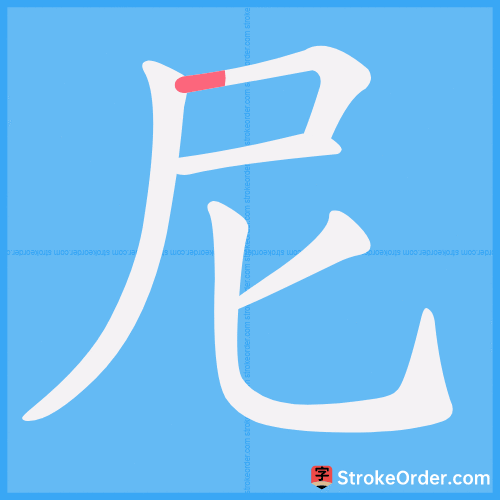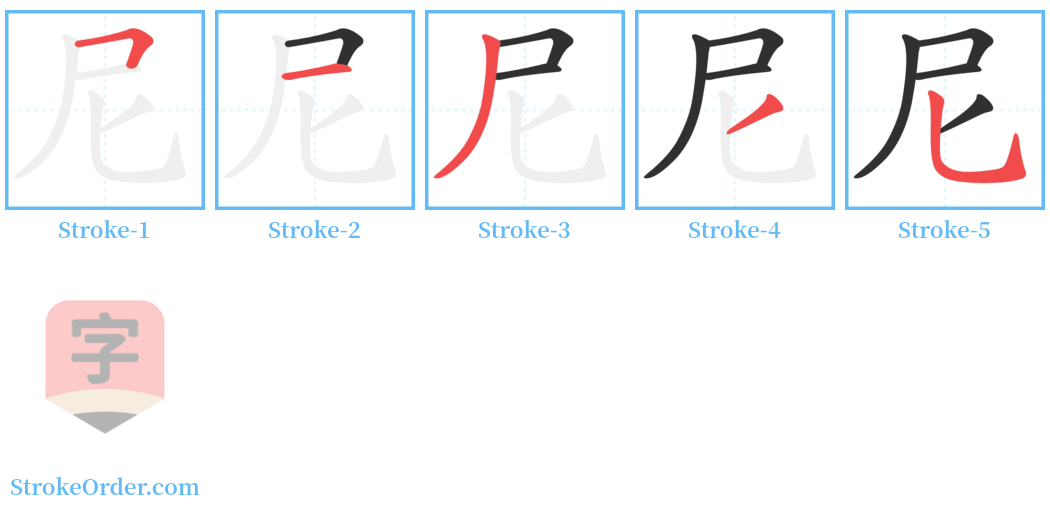尼 Stroke Order
Animated Stroke Order of 尼

Stroke Order Diagrams for 尼

Step-by-Step Handwriting Guide for 尼

Learn to Write Chinese Characters with Video Tutorials
Watch the video of writing the Chinese character "尼", learn the correct stroke order (笔顺) of the character "尼", and master the standard way of writing the character "尼".
Free Printable Handwriting Practice with Stroke Order: 尼
Printable Writing Practice Worksheet of "尼" in Portrait Orientation (Tian Zi Ge)

Printable Writing Practice Worksheet of "尼" in Landscape Orientation (Tian Zi Ge)

Information of 尼
Pinyin
ní
Radical
尸
Strokes
5 strokes
Usage
★★★★★
Definition
Buddhist nun / (often used in phonetic spellings)
尼 [ní]
1. Short for the Sanskrit term "比丘尼" (Bhikṣunī), referring to a woman who has renounced worldly life and practices Buddhism. Examples include: 尼姑 (nun), 尼庵 (nunnery), 削发为尼 (to shave one's head and become a nun).
2. An ancient term synonymous with “昵,” meaning close or intimate.
尼 [ní]
1. A nun; a woman who has renounced worldly life and engages in Buddhist practice. It is an abbreviation for the Sanskrit term "比丘尼" (Bhikṣunī).
2. Ni Hill, believed to be the birthplace of Confucius.
尼 [ní]
1. To be intimate; a term historically related to closeness.
- Referenced in "说文": 尼, from 后近之也 (meaning 'close behind').
- In "小尔雅": 尼,近也 (meaning 'near'). It is noted that in context, it may be written as 昵.
- Cited in "尸子": 不避远尼.
2. To be peaceful and calm.
- According to "尔雅": 尼, 安也 (meaning 'peaceful').
- As mentioned in "广雅": 尼, 和也 (meaning 'harmonious').
- Quoted from "隶释·祝睦后碑": 竟界尼康.
尼 [nǐ]
1. To impede; to obstruct.
- As found in "墨子": 淫嚣不静,当路尼众 (meaning 'the noisy and chaotic must be obstructed').
- Example usage: 尼行 (to stop or impede progress); 尼阻 (to hinder or obstruct).
2. Further references can be seen under ní.
Netanyahu (name) / Benjamin Netanyahu (1949-), Israeli Likud politician, prime minister 1996-1999 and from 2009
Input Method for 尼
Pinyin
ni2
Wubi
nxv
Cangjie
sp
Zhengma
xmrr
Four Corner
77212
Unicode
U+5c3c
Same Pronunciation Characters